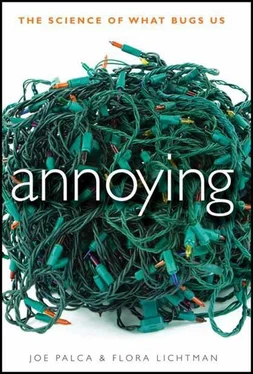I imagine that soon he will begin to take things apart. He will methodically dismantle all of the electrical devices in his office, creating an unusually precise metaphor for what is happening in his psyche.
I am reminded what a thin and fragile thread keeps us attached to sanity. Today, this tiny little device helped me break a co-worker’s mind, and I thank you for the sinfully pleasurable schadenfreude.
My best to you,
John Seattle, WA
Uncle Ted bought the original Annoy-a-tron. ThinkGeek has since released the Annoy-a-tron 2.0. The newer model is slightly larger and has a few more sounds and a volume control. It’s also more expensive. How do you take something that already seems perfectly annoying and improve it? And, why would you?
When volunteers join the Park Slope Volunteer Ambulance Corps, many have to be taught how to drive an ambulance in New York City, which includes siren protocols. Dale Garcia, who has been with the PSVAC for eighteen years and is now the executive officer at the corps, says that his training method is fear-based. “I make them terrified to drive, and then I make them drive.” It’s all about confidence building, he says.
Sirens are an important component of driving an ambulance. In New York City, ambulances are required to turn on their lights and sirens when responding to emergency calls. That also goes for volunteer ambulance drivers, such as those at the Park Slope Corps. It sounds like a reasonable law, but it doesn’t always seem that way to Garcia, who dislikes annoying his neighbors with the noise at 4 a.m. when the streets are empty.
One of the few ground rules for using sirens is that if you’re going through an intersection, you’re instructed to change the siren call. Studies have shown, and common sense confirms, that intersections pose the greatest risk for collisions between EMS vehicles and everything else. The idea is that the change in sound makes the siren harder to ignore. This is a fact that has become so familiar it’s easy to lose sight of how astonishing it really is: even an ambulance siren can fade into the background if it’s too predictable.
The use of a siren seems to be more an art than a science. In the basement of the corps, Will Tung takes out a marker and draws a diagram of the sirens available to him and his preferred style. “There are three siren tones. The Wail—which is the classic waahh wow waahh wow. The Yelp, which is a faster wail. And the third one—I call it the phaser. It sounds sort of like nails scratching a chalkboard. Each steps up in rapidness. I usually leave it on Wail, and approaching an intersection I go to Yelp and then back to Wail.” He pulls out the phaser only for real tough jams.
In addition to being annoying, part of what makes a siren effective is that people recognize it as a siren. There are nationwide standards, set out largely by the Society of Automotive Engineers, that guide siren makers on what frequencies of sound are designated for emergency vehicles. The frequencies haven’t changed significantly over the years, according to one siren maker, but siren users have gotten creative.
In one of the corps ambulances, on an industrial block in downtown Brooklyn, Tung demonstrates the sirens. Where the cup holder is in your car, there’s the “Whelan” in this ambulance. There’s a red switch to turn it on and off and a knob that can be set to T3 (that’s the phaser), Yelp, Wail, HF (for handsfree), MAN, PA, and RAD (for radio). There’s a button for a synthetic air horn. Fire trucks still have real air horns, Tung says.
Will likes PA for cruising around—“a yelp with a tail,” he says. It’s what most FDNY EMS drivers use. There are tricks to remixing the sirens. Certain settings allow you to control them with the horn and the megaphone, allowing for maximum siren control. There are ways to get the sirens to cycle automatically or move up in pitch as they go through the calls. “That gets people to move because it’s really annoying,” Tung says.
Yet in a city like New York, which not only never sleeps but never really shuts up either, sirens aren’t always annoying enough. Dale Garcia and Will Tung agreed that many drivers either don’t or can’t seem to get out of the way of an ambulance.
Garcia thinks that New Yorkers may be especially good at ignoring things. For example, one bitter cold night on 3rd Avenue and 5th Street in Brooklyn, a car caught on fire. When Garcia arrived, thirty-foot flames were shooting out of the car. Fortunately, there was space around the vehicle, and Garcia parked the ambulance near the car to block off the area and keep people at a safe distance. Then, in what seemed like an (almost) impossible New York minute, a man came up to Garcia’s ambulance, knocked on the window, and said, “Could you move your ambulance? I’d like to park my car.”
Some of us are better than others at paying attention only to the things we want to pay attention to. The job of an EMS driver—or an Annoy-a-tron designer—is to overcome everyone’s ability to ignore things.
David Huron is interested in music and our brains. He’s a musicologist and the head of the Cognitive and Systematic Musicology Laboratory in the School of Music at Ohio State University. In studying why humans are so enthusiastic about some sounds, he’s turned up a wealth of insights into what makes us so unenthusiastic about others. As the cell phone studies suggest, attention-grabbing noises often provoke the most backlash.
Nature is a good place to look for answers to most questions, including what makes a sound intrinsically annoying.
You’re sitting outside on the deck of your house. You’ve got the newspaper and your morning coffee. A fly comes by and decides that your head is the most interesting and entertaining thing it has ever seen. It never seems to tire of buzzing around and around your ears. It’s not deterred by the newspaper, which has now been rolled up for use as a weapon. The swatting seems to add to the fly’s thrill. The morning paper and coffee may soothe you, but they’re no matches for the fly. There’s never a time when a fly buzzing around your head isn’t annoying. What accounts for this?
It’s partly about the optimism that someday the fly will find someone else’s head to circle. It’s partly that the exact route the fly takes around your ears is unpredictable. It’s partly unpleasant because flies are a little gross—they remind us of dog poop and rotting carcasses. Yet there’s something else about flies—the sound their little wings produce is unpleasant.
Fly: zzzzzzZZZZZZZzzzzzzzz…
You: Maybe it’s gone.
Fly: ZZZZZZZZZ!
Flies are not trying to get your attention; they’re born with that ability.
When flies zip to and fro past your ears, the volume of the buzz changes as it moves closer and farther away. This erratic volume change is akin to the concept of roughness. Roughness is the measure of the change in amplitude of a sound vibration over time—the rate at which the sound gets louder and softer. Slow roughness is called beating—you’ve probably heard it when someone tunes a guitar. Fast roughness melts into a hum. If the roughness is just right, though, it’s hard on the ears. “What roughness does is that it actually interferes with the ability of the auditory system to pull information out of the environment,” says Huron. His theory is that because roughness makes it hard for us to hear other things, we don’t like it. There’s a good evolutionary reason not to like rough sounds because they interfere with our ability to perceive other sounds around us, he says. “It’s one of the reasons why French people find English annoying. French is not a very highly inflected language. Each of the syllables tends to be equivalent—roughly the same in duration, approximately the same in amplitude or loudness. It sounds a bit like a sewing machine. It’s ta tatatata.
Читать дальше












